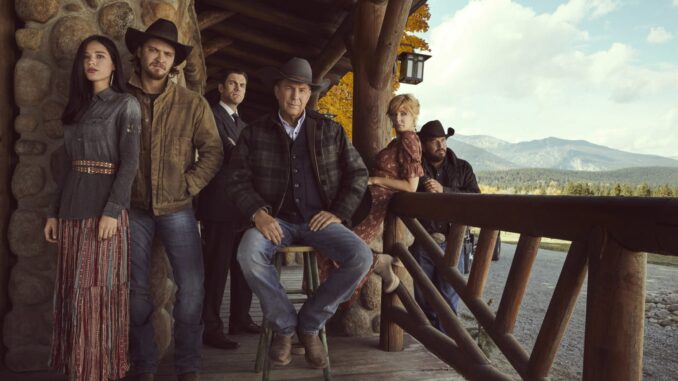
The Digital Range War: Inside the Paramount vs. Peacock Yellowstone Spin-Off Streaming Feud
In the rugged, beautiful world of the Dutton family, loyalty is paramount, land is everything, and the lines of conflict are drawn in blood. But outside the fictional boundaries of the Yellowstone Ranch, another fierce battle rages – a digital range war for the soul of the franchise, pitting corporate giants Paramount Global against NBCUniversal's Peacock. This isn't just a squabble over viewership; it's a stark, illustrative example of the messy, unpredictable, and often frustrating reality of the streaming wars, born from legacy deals, unexpected success, and the relentless pursuit of subscriber growth.
The genesis of this peculiar feud lies in a time before the streaming landscape became the fragmented, subscription-heavy ecosystem we know today. Back in 2020, before Yellowstone had truly become the seismic cultural phenomenon it is now, NBCUniversal inked a licensing deal with ViacomCBS (now Paramount Global) to acquire the streaming rights for the series. It was a perfectly sensible move at the time; Yellowstone was a popular cable show, and Peacock needed content to launch its nascent platform. What no one truly anticipated was the show's meteoric rise, particularly during the pandemic, transforming it into a bona fide "tentpole" series – a crown jewel that would drive millions to any platform it called home.
Suddenly, Paramount Global, who owned the show's linear network (Paramount Network) and all its intellectual property, found themselves in an acutely painful position: their hottest property, the very show defining their brand in the eyes of millions, was sending potential subscribers directly to a competitor's streaming service, Peacock. It was like owning the gold mine but having signed away the rights to transport the ore. This wasn't an accident; it was a relic of a bygone era of content licensing, a pre-war truce that had, in hindsight, become a strategic blunder of epic proportions.
Enter Paramount Global's grand strategy, a calculated counter-strike born of necessity: if they couldn't claw back the original Yellowstone immediately, they would build a new Yellowstone universe exclusively on their own burgeoning streaming platform, Paramount+. This is where the creative genius of Taylor Sheridan became not just a celebrated showrunner, but a strategic weapon. Sheridan was given an unprecedented green light to expand the Dutton saga through prequels and spin-offs, all destined for Paramount+.
The result was 1883, a critically acclaimed and highly successful prequel that brought millions of new subscribers to Paramount+. This was followed by 1923, starring Harrison Ford and Helen Mirren, further solidifying Paramount+'s claim to the Yellowstone legacy. And it didn't stop there. Sheridan's prolific output, including Mayor of Kingstown and Tulsa King, also found their exclusive streaming homes on Paramount+, effectively creating a "Sheridan-verse" that became synonymous with the new streamer. The message was clear: if you wanted the Yellowstone universe, if you wanted the complete story of the Duttons, if you wanted the latest from Taylor Sheridan, you needed Paramount+.
The result, for the average viewer, is a Byzantine roadmap to the Yellowstone experience. You can watch the current seasons of Yellowstone on the Paramount Network cable channel. But if you want to stream past seasons of Yellowstone, you must subscribe to Peacock. If you want to watch 1883 or 1923, you need a Paramount+ subscription. And if you want to see other shows from the same creative mind, Tulsa King or Mayor of Kingstown, that's also Paramount+. It's a digital scavenger hunt, a forced two-subscription model, and a constant source of confusion and frustration for fans simply trying to follow their favorite story.
This feud illustrates several critical dynamics of the streaming era:
- The Perils of Legacy Deals: What seemed like a fair licensing agreement years ago can become an albatross when a show explodes in popularity, binding the content owner to a competitor.
- The Power of Exclusive Content: Paramount Global's aggressive investment in the Taylor Sheridan universe demonstrates how original, exclusive content, especially from a beloved franchise, is the ultimate weapon in the streaming wars. It's not just about attracting subscribers; it's about reducing churn by making a platform indispensable.
- The Cost to the Consumer: While companies battle for market share and subscriber numbers, the burden often falls on the audience, who must navigate a fragmented landscape, juggle multiple subscriptions, and pay more to access content that, logically, should reside under one roof. The Yellowstone saga, once a simple cable watch, has become a multi-platform financial commitment.
- The Shifting Definition of "Home": For a long time, the network that aired a show was its home. In the streaming era, "home" is increasingly where its streaming rights reside, and this can be a very different place, leading to strategic headaches and consumer confusion.
The Paramount vs. Peacock Yellowstone feud is more than just corporate jostling; it's a real-time case study in the evolution of media consumption. It shows how the unexpected success of a single property can derail carefully laid plans, how content owners fight to reclaim their intellectual property, and how, in the end, the audience is caught in the crossfire of a digital range war, forced to subscribe to multiple services just to keep up with the Duttons and their ever-expanding, increasingly complex family saga. And until that initial streaming deal for the flagship series expires, this unique, bewildering arrangement will continue to be a testament to the wild, untamed frontier of streaming.
